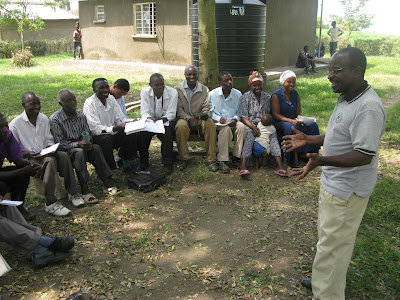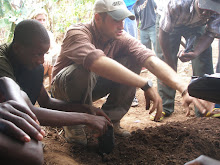In my last post I talked about the importance of supporting
the ambitious young people of a community in order to ensure a brighter future
for the entire community, now I’d like to talk about an opportunity to do just
that. Peter Zgambo is a bright ambitious
young man, who I have tremendous faith in.
He was one of the first kids I got to know in Mwazisi. He was my neighbor, and his father Charles
Zgambo was my close friend and trusted counterpart as the local department of
forestry extension worker. Charles and I
did a number of projects together ranging from treadle pump irrigation to tree
nurseries. Charles was always
open-minded enogh to try out new projects, but also level-headed enough to tell
me when he didn’t think a project was going over well, which is a perfect blend
for an extension worker.
When Peter was in primary school he used to come over to my
house to listen to the BBC on the radio and work out with my makeshift
weights. He often helped me in the
garden, while practicing his English with me.
He was always a hard worker and curious about the different agriculture
projects I was working on. He finished
primary school the top of his class, and
moved on to the Mwazisi community day secondary school. I taught him in Form 1 Physical Science and
History, and he was always one of my best students. He decided to transfer to Ekwendeni after
form 2 because Mwazisi didn’t offer form 3 and 4 physical science classes,
which he wanted to take. He passed his
MSCE’s doing particularly well in math, biology, physical science, agriculture,
and social and development studies.
Immediately after graduating he sat for several college
entrance exams, and got into his first choice The Natural Resource College (NRC)
near Lilongwe. The NRC was set up by the
Ministry of Agriculture along with the Canadian International Development
Agency (CIDA) as a training center for technical assistance in the field of
Agriculture. The NRC offers classes in
everything from Crop science, and swine production, to Mushroom cultivation and
agroforestry. They have a 160-acre farm
where students get practical experience, and a well renowned research lab.
The NRC is right down the road from one of the most
impressive permaculture demonstrations that I have ever seen. It is the home of two former Peace Corps
volunteers Stacia and Kristof Nordin who arrived in Malawi in 1997 to do HIV
prevention work. They saw connections
between the communities health problems, malnutrition, lack of diversity in the
diet, and degrading soil fertility.
Seeing the natural connection between these problems led them to
Permaculture. Over time they made their
home into a permaculture education center, and developed a permaculture
demonstration village on the neighboring property with forward thinking
community members. Over the years the
Nordins have introduced thousands of people to Permaculture through their own
demonstrations and their work with primary schools. I can’t do their work justice, so please
visit their website: www.neverendingfood.org
and see for yourself the good work that they are doing. Kristoff and Stacia were good friends of mine
when I was working in the Peace Corps. I brought Peter’s father Charles to
visit their demonstration gardens once when we traveled to a Peace Corps
training together and it made a strong impression on him. Peter is already aware of the ideas behind
permaculture from the time he spent with me, so I think having the opportunity
to regularly visit the Nordins would be the perfect counterbalance to the more
conventional agriculture education he will get at the NRC.
The only problem is school fees. it costs about $1,500 per
semester to go to the NRC. Charles,
Peter’s father, told me that when his son showed him the newspaper announcing
the students who passed the entrance exams and he saw Peter’s name, he was
completely speechless, partially because he was so proud of Peter, but also
because he knew there was no way he could pay for the school fees. The Zgambos had five to six children living
with them the entire time I was in the Peace Corps, and it wasn’t until near
the end of my service that I realized only Peter and his brother Happy were
actually the children of Charles and his wife.
The rest were nephews or nieces, and sometimes even further removed
relatives,. They were treated the same, so much so that there was no way for me
to know that the other’s were not the Zgambo’s children. But they paid for all of their secondary
school fees, and provided them with everything they needed, for as long as they
were in Mwazisi. I think it must be
heart breaking for Charles to know he can’t send Peter to school after all he
has accomplished
The reason I am writing this blog is because I want to help
Peter pay his tuition but I can’t afford to cover his tuition alone. Catherine and I have set up an Indiegogo campaign to try to raise the necessary funds to send Peter to the NRC and get him started on a path to making a difference in Malawi. Please visit our website: http://www.indiegogo.com/projects/mwazisi-agricultural-education-fund/x/4558745 and watch the video Catherine made introducing you to the beauty of Mwazisi through her pictures while I explain a bit more about the farming situation there and how I think Peter can make a difference.
We started with a low goal of $3,000 which will only cover his first year at the NRC, because I wasn't sure what the response would be, but we are hoping to raise much more than that so we can pay for his entire tuition from beginning to end...so if you can please contribute early and often! If we raise more than we need for Peter than the money will go towards other young promising people from Mwazisi that I am already paying school fees for: Sam Gondwe who is also in Lilongwe now going to the Malawi school of tourism, and Mathews Mkandawire who is in Blantyre going to accounting school. If you can't contribute, don't worry you can still help by getting the word out, please use your social media magic to help us reach the people who can contribute, and together we will meet our goal in no time!
Thank You

























